Carnforth MPD
Carnforth MPD (Motive Power Depot) is a former LMS railway depot located in the town of Carnforth, Lancashire.
Developed in 1944 on the site of the former London and North Western Railway depot, its late construction in the steam locomotive age resulted in its long-term use and conservation by British Railways. Targeted as part of a preservation scheme, when this failed it was developed as major visitor attraction Steamtown Carnforth. Today, closed as a museum, it acts as the major national operational base of West Coast Railways.
Importance of Carnforth
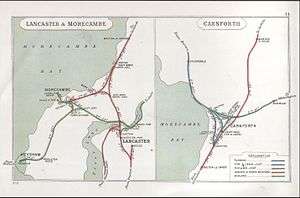
Carnforth was not an important or well developed village before the Victorian era railway age, but was geographically strategically located to make it so. While supplies of limestone made it interesting, access into Westmorland, the Lake District and the coast of Cumberland beyond made it an ideal transport hub point.
Carnforth railway station opened as a single platform wooden structure for access to the then village, but was made into a permanent stone structure by the Lancaster and Carlisle Railway (L&CR) in 1846. In 1857 it became a junction station when the Ulverston and Lancaster Railway used it, as did the Furness Railway soon afterwards after taking control of the ULR. In the 1870s architect William Tite redesigned the station and layout, allowing Midland Railway trains access. The regionally competing London and North Western Railway (LNWR) took over the L&CR, and created a jointly - This growth continued from the late-Victorian era to post World War II and into the early 1950s. At its height Carnforth handled up to 100 trains a day of holidaymakers, commuters, freight and fuel bound for the seaside, cities, ports and industrial centres.[1]
History
.jpg)
When the Midland Railway reached Carnforth in 1857, it developed an extensive roundhouse depot and maintenance shed to service its locomotive stock. The building today is still in use as a light industrial facility.[2] In the 1880s the LNWR had rebuilt the small 2-road L&CR facility adjacent to the station into a standard-pattern LNWR 6-road facility.
Carnforth MPD: 10A
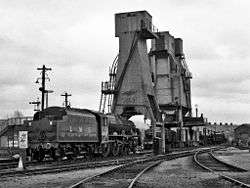
At the railway grouping in 1923, the London Midland and Scottish Railway was created by amalgamation of the MR and the LNWR with other railway companies. While the former MR roundhouse was used for passenger types, the former LNWR shed was used for freight locomotives.
From 1936 onwards under instruction from the Air Ministry's Sir Kingsley Wood, in a programme headed by Herbert Austin many key industries in London and the industrialised Midlands, had created a shadow factory infrastructure to enable production should war break out. Many of these shadow factories, plus a number of Royal Ordnance Factories, had been deliberately located in Cumbria and the Northwest coast, out of range of the bombers of the Nazi Luftwaffe. Consequently, when World War 2 did break out, with a combination of additional staff moved and recruited to these facilities, plus the raw materials going in and requirement of distribution of output, the transport result was a relative boom in both freight and passenger traffic.
With the United States involved in the war from 1941, planning for Operation Overlord the invasion of Europe began. The Port of Liverpool and the west coast ports of Scotland were key to importing war machinery and supplies from North America, as well as distributing US Army and Canadian Army troops across England for training, again initially in the northwest and northeast. The combination of these factors put a huge strain on local locomotive servicing facilities at Carnforth. Therefore, in late 1942, the Government agreed to fund the construction of a new shed at Carnforth, to allow for the new and planned level of locomotive servicing requirement. Built on the site of the former LNWR facility and opened in 1944,[2] it allowed for the servicing of many more locomotives, and together with highly mechanised supporting infrastructure greatly reduced the need for operational manpower.
On nationalisation in 1948, British Railways inherited an almost brand new depot (Code:10A), which was bigger—due to a now lack of war activity—than was required. This allowed them to close a number of other local and older or less efficient sheds, and secondly to keep the shed open longer than many when the decision to modernise traction to electric and diesel came. As a result, Carnforth MPD remained relatively undeveloped from its reconstruction in 1944, by the time it closed in 1968.
Steamtown Carnforth
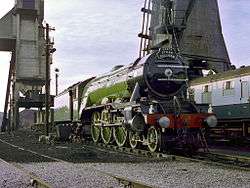
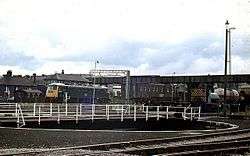
BR closed the Lakeside branch to passengers on 6 September 1965, and to all traffic two years later.[3]
A group of enthusiasts chaired by Dr Peter Beet formed the Lakeside Railway Estates Company, with the idea of preserving both the line and Carnforth MPD, to provide a complete steam operating system.[4] Negotiations with BR resulted in an agreement to buy the majority of the Lakeside branch, and at Carnforth rent out: the former wagon works; west side sidings; and 3-roads of the former MPD. Beet formed Steamtown Railway Museum Ltd,[4] and the resultant visitor attraction Steamtown Carnforth became a mecca for steam enthusiasts, then facing a national ban on steam traction on the BR network. With the assistance of the Lancaster Railway Circle, an increasing number of steam engines arrived at Steamtown from 1967 onwards.
However, although backed by then transport minister Barbara Castle, the need to build a number of motorway bridges and re-routing of the A590 road from Haverthwaite via Greenodd to Plumpton Junction, meant that the complete vision was unsuccessful. This caused a split within the Lakeside Railway society in 1970, with one part of the group forming the Lakeside & Haverthwaite Railway to operate the residual line, taking four of the engines with them.
Steamtown continued under the leadership of Dr Beet, who developed it as a major regional visitor attraction. This included the purchase of both SNCF Chapelon Pacific No. 231.K.22, Deutsche Bundesbahn oil-fired 012 Pacific No. 012 104-6 (né 01 1104), and the development of an extensive 15 in (381 mm) miniature railway.[5]
In 1974 Sir Bill McAlpine became a shareholder in the company,[4] allowing his LNER A3 Pacific 4472 Flying Scotsman to make Carnforth its home for many years.[6] Subsequently, McAlpine acquired a controlling interest in the company, in order to fund the purchase of the complete site including the track from BR.
Even after the mainline steam ban was removed in the early 1970s, the site remained a hub for both enthusiasts and major servicing point for steam locomotives and associated rolling stock. The museums own stock developed with the purchase of some ex-industrial shunters, and three hulks from Woodham Brothers scrapyard at Barry Island: GWR 6959 Class No.6960 Raveningham Hall; SR Merchant Navy class No.35005 Canadian Pacific; GWR 5600 Class No.5643.[7]
West Coast Railways
McAlpine's interest declined, and resultantly so did Steamtown through lack of investment. In 1990 McAlpine's controlling stake in Steamtown Railway Museum Ltd was sold to David Smith, who over the following years has bought out the majority of the minority shareholders.[8]
With increasing Health and Safety Executive regulations, and an increased reliance on revenue from supplying and servicing steam locomotives to power enthusiast trains, the commercial decision was taken not to reopen Carnforth as a museum or visitor attraction for the 1998 season.
Steamtown Railway Museum Ltd still exists today as a holding company, and operates an extensive railway repair and operating facility on the site. Smith later set up West Coast Railways, which operates heritage steam and diesel trains across the national UK railway network.[4]
Steam locomotives based at Carnforth
A number of steam locomotives are based at Carnforth Motive Power Depot and either stay at the shed for winter maintenance or are based and operate off the shed 24/7.
| Class | Name & Number | Image | Current location | Current status | Notes |
|---|---|---|---|---|---|
 |
Static display since July 2014. | Mainline certificate expired in 2014 now awaiting overhaul, currently wears the fictitious Hogwarts Livery and a castle name (The Castles being a much larger class of engine built by the GWR). | |||
.jpg) |
Stored, Awaiting overhaul | Moved by rail from Mid Hants Railway to Southall in June 2014 and from Southall to Carnforth MPD the following month. Presently stored pending a mainline standard overhaul. | |||
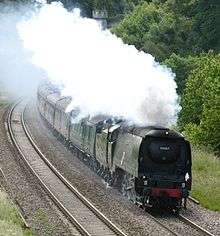 |
Undergoing overhaul | ||||
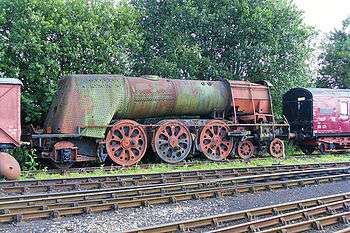 |
Stored, Awaiting restoration | Currently stored at 10A shed awaiting restoration from scrapyard condition. | |||
 |
Operational, Mainline Certified (2017–2024) | It visited the Wensleydale Railway for the 1940s Weekend on 21 and 22 July 2018. | |||
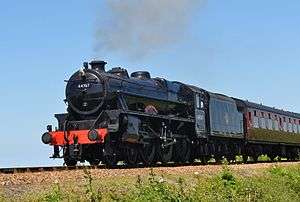 |
Stored, Awaiting overhaul | Recently acquired from Ian Storey | |||
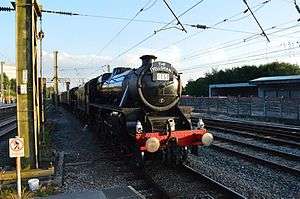 |
Undergoing overhaul | ||||
| Operational, Mainline Certified (2014–2021) | |||||
| Operational, Mainline Certified (2013–2023) | Following repaint from BR crimson lake into BR lined green with the later BR crest in Nov 2019, 45699 is presently running in the identity of scrapped classmate No. 45562 Alberta. | ||||
| Operational, Mainline Certified (2019-2026) | |||||
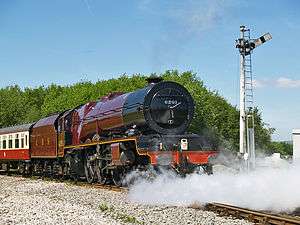 |
Operational, Mainline Certified (2019–2026) | Arrived by rail from the Midland Railway at Butterley so that major boiler repairs and other required work could be undertook on the engine, the engine made a test run on the 14 March 2019.
It originally returned to service in 2016 following overhaul at Tyseley Locomotive Works but withdrawn prior to the end of 2016 due to multiple mechanical problems. | |||
| Withdrawn for Overhaul. (Ran her last tour in August 2019) | |||||
.jpg) |
Operational, Mainline Certified (2012–2019) | ||||
References
- "History". CarnforthPlatforms.org. Retrieved 6 February 2012.
- "North West Railway". railbrit.co.uk. Retrieved 6 February 2012.
- Butt 1995, p. 115
- "Obituary - Dr Peter Beet". The Guardian. 7 December 2005. Retrieved 2 January 2011.
- "Steamtown miniature railway". Mike Hanson. Archived from the original on 6 January 2011. Retrieved 2 January 2011.
- "Steamtown Museum, carnforth". BBC Domesday. 6 February 2012.
- "Steamtown early 1970s". Mike Hanson. Archived from the original on 23 October 2012. Retrieved 2 January 2011.
- A Brief Encouter with Harry Potter Rail issue 568 20 June 2007 page 40
Sources
- Butt, R. V. J. (1995). The Directory of Railway Stations: details every public and private passenger station, halt, platform and stopping place, past and present (1st ed.). Sparkford: Patrick Stephens Ltd. ISBN 978-1-85260-508-7. OCLC 60251199.